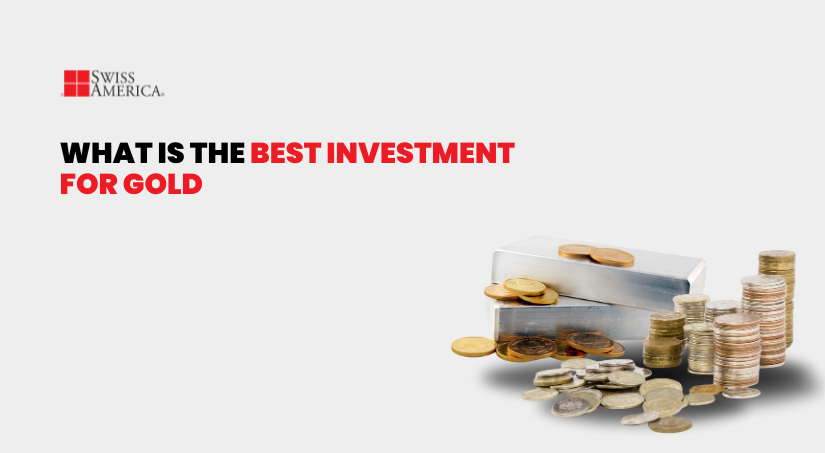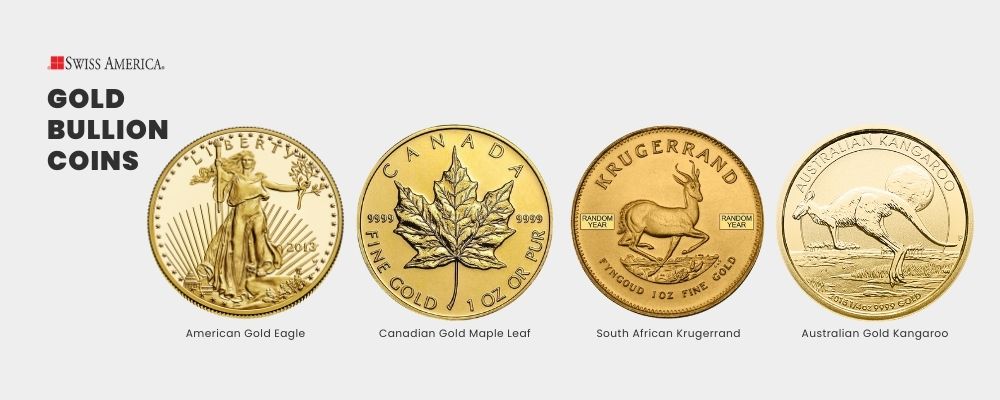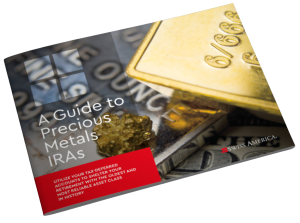
Why do different investors choose such different approaches to gold? Some swear by physical coins and bars, others like mining stocks or ETFs – and their returns can vary dramatically.
As of this writing, the election is over, and investors are feeling good. The stock market rallied, Bitcoin surged, and gold rose in hopes of reduced interest rates. Despite this, 74% of Americans worry about the price of food and goods. So, what comes next for our economy?
No one knows for sure, which is exactly why countries keep adding gold reserves and individual investors keep buying gold bullion coins and bars. The World Gold Council recently reported that gold demand exceeded $100 billion for the first time ever on record.
So, with gold funds, companies, and physical pure gold all hitting record highs, learn what is the best investment for gold and how to add this tangible asset to your portfolio.
Types of gold investments
What type of ways can you invest in gold to give you a long-term safe haven asset?
Physical Gold
Physical gold, where you actually own gold coins and bars, is the oldest and best investment method. Why? The closer you get to owning actual tangible assets, the greater your control and the lower your risk.
So, how do you invest in physical gold bullion?
Gold bars
Gold bars are best if you’re looking to buy larger quantities of the metal because they offer lower premiums over the market price compared to coins. It’s like buying in bulk.
Plus, you can easily stack gold bars, which makes it easier to store them.
Gold coins
Gold coins are smaller and range from 1/10 ounce to 1 ounce in weight. Most people buy 1 oz coins like:
Canadian Gold Maple Leaf
South African Krugerrand
- Australian Gold Kangaroo
Coins are very portable, and most people around the world recognize them. So, if you want an investment that you can easily carry with you, coins are a great option.

Advantages of physical gold
Physical gold is immune to risks associated with digital assets, such as hacking, cyberattacks, and system outages. In today’s world, it’s refreshing to have a solid asset that doesn’t rely on electronic systems, passwords, or online accounts.
This gives many investors peace of mind, knowing they have an “offline” way to protect wealth.
Gold’s compact size and high value make it one of the most portable forms of value. A 1-ounce gold coin worth thousands of dollars can easily fit in your pocket or a small safe.
As Reddit user TickletheEther explains in r/investing forum, “Gold is a store of value without counterparty risk. You can store ALOT of wealth in a very small place, which is convenient.“
Plus, no other way of investing in gold gives you a tangible asset. You can actually hold gold coins or bars in your hand and control what you do with it. This puts you in the driver’s seat for your portfolio and your wealth.
Disadvantages of physical gold
Physical gold doesn’t generate passive income. It doesn’t provide dividends or interests, and its value depends on market performance. Most of the time, investors are OK with this because the whole point of owning gold is to protect wealth.
It’s more like an insurance policy versus an asset where you expect a certain annual return on your investment.
Owning physical gold also means you’ll need to find secure storage and buy insurance. The cost of these can add to your expenses, so just be sure to include them in your gold ownership plans.
Gold ETFs and mutual funds
Gold exchange-traded funds (ETFs) and gold mutual funds invest in a blended portfolio of gold mining stocks, bullion, or futures. Investment managers handle these funds and decide on the blend of asset classes they hold.
Advantages of Gold ETFs or mutual funds
Mutual funds are managed by professionals who decide based on market conditions. This might be good if you don’t have the time or expertise to monitor the market for gold paper assets. It also gives you exposure to several types of gold investments.
Disadvantages of Gold ETFs or mutual funds
ETFs and mutual funds charge management fees and expense ratios, which reduces your returns over time. These fees vary depending on the fund, but they are an ongoing cost that you’ll have to account for. Also, you have to rely on these third-party custodians or fund managers. If the managing entity has financial difficulties or fails to back its holdings, you could lose money.
Gold Stocks and mining companies
You might decide to buy shares of gold mining companies that explore, extract, and produce gold. This gives you exposure to gold prices and the potential to benefit if the company has strong operations.
Advantages of gold mining stocks
If the company does well, you might make higher returns versus owning physical gold. Plus, mining companies operate globally, which could bring new opportunities if they find metals in other parts of the world.
Disadvantages of gold mining stocks
Other market risks impact these stocks, like equity market volatility or investor sentiment. This means your holdings could underperform even when gold’s value rises.
Mining stock values depend on how well the company operates. Poor exploration, production, or financial decisions can cause underperformance. Even if gold mining companies can provide high returns in gold markets, they can also experience large losses during downturns, usually more severe than the decline in gold prices themselves.
Gold Futures and options
Gold futures and options let investors speculate on the price of gold via paper asset holdings. You enter into a contract to buy or sell gold at a specific price in the future.
Advantages of gold futures
You can use futures and options to get into gold with a small upfront investment, known as a margin. This can increase your returns and provide gains in the short term.
Disadvantages of gold futures
Futures and options require a deep understanding of financial markets, pricing mechanisms, and trading strategies. If you’re a new investor in gold futures contracts, it can be hard to learn and manage, and you might lose a lot of money.
These contracts have expiration dates, so you have to monitor and manage your positions actively. If you hold contracts beyond their term, they roll over, which can increase your costs.
Gold futures and options also react very quickly to price swings in the gold market. If something changes with your gold futures contract and you don’t catch it, you can lose a lot of your investment.
Factors influencing gold investment decisions
To get a better idea of how gold reacts to the market and overall conditions, consider the following:
Interest rates and economic conditions
When interest rates rise, gold normally struggles because it doesn’t generate income. Investors looking for a safe place to “park” their cash might use a high-yield savings account instead. This relationship changes with lower interest rates because inflation outpaces what you can earn in interest. That’s when gold tends to shine.
Gold responds to major economic shifts in different ways:
During the 1970s, inflation soared, and gold jumped from $35 to $800 per ounce.
In the 2008 crisis, gold rose because people feared bank failures, not inflation.
Today, central banks are buying gold faster than they have in decades.
Even with high interest rates available, people are choosing gold as insurance.
The daily price of gold mostly depends on professional traders, and ETF flows rather than physical buyers of jewelry or coins. These traders react quickly to changes in interest rates and signs of financial stress. But the bigger picture often comes down to a simple question: Do people trust the financial system and paper money, or are they getting nervous?
People seem more worried about what could go wrong in the world than they are tempted by high yields on bonds and savings accounts. They’re paying the price to hold gold because they’d rather have real money than paper promises.
Risk tolerance and investment goals
Physical gold just sits in your safe, doing exactly what it’s supposed to do – nothing. It’s not like stocks or bonds, where you have to watch them. You just need to decide how much of your money you want in something that’s real and can’t go bankrupt.
Key ways people use physical gold:
Retirees might keep it at 5% since they need income from their other investments.
Younger investors might hold more since they can ride out price swings.
Families can pass it down through generations as a preserved store of wealth.
ETFs and mining stocks come with extra risks – you’re counting on financial companies staying healthy or mines staying profitable. Physical gold cuts out these middlemen. It’s been valuable for thousands of years and doesn’t need a financial system to keep working.
The key is thinking about why you want gold. If you’re buying because you think the price will double next year, you’ll probably be disappointed. But physical gold makes sense if you want something solid that might hold up when everything else falls apart.
Portfolio diversification and gold
When stocks tank, gold usually goes in the opposite direction. That’s what makes it useful in a portfolio. It’s not that gold always goes up when stocks go down, but it tends to follow different rules. Recently, we saw this with:
2008: The stock market nearly crashed, and banks failed. Many investments got crushed, and gold actually rose.
COVID-19: The market crashed again in 2020, and gold prices increased by over 53%.
Adding some gold to a stock and bond portfolio is like buying insurance. You might not need it most years, but when markets get ugly, you’ll be glad you have something not tied to the financial system.
Evaluating past performance and future outlook
Each crisis tells a different story about gold. In the 1970s, inflation sent it soaring. During the boom years of the 1980s and 90s, it mostly sat there doing nothing. But since 2000, it’s bounced up during every major crisis – the dot-com crash, 2008, COVID-19, and today’s uncertainty.
Right now, we see rising government debt, geopolitical tensions, and central banks loading up on gold. People are nervous about the financial system in a way we haven’t seen since 2008. It’s why Goldman Sachs recommends holding gold and recently shared:
“Gold is our strategists’ preferred near-term long (the commodity they most expect to go up in the short term), and it’s also their preferred hedge against geopolitical and financial risks.”
How do beginners buy gold?
If you’re thinking about investing in gold, here’s how you can get started:
Step 1: Choose a trusted dealer
Find a reputable dealer with positive reviews and affiliations with trusted groups like the American Numismatic Association (ANA) or Professional Numismatists Guild (PNG). Consider joining the thousands of happy customers that work with Swiss America for their gold investments.
Always work with dealers who provide certificates or serial numbers for gold. For added assurance, you’ll also want documentation from trusted mints like the U.S. Mint or Royal Canadian Mint.
Step 2: Buy gold
If you are buying gold coins or bars with non-retirement funds, you can buy whatever gold you’d like. Our expert brokers can walk you through the various options and help you decide what makes the most sense for your situation.
In scenarios where you plan to use retirement funds like rolling over a 401(k), converting an IRA, or starting a new Gold IRA, there are IRS rules about which metals you can buy. Generally, the IRS looks for specific purity and manufacturing standards.
Step 3: Store and monitor
Once you buy your metals, you can either receive them directly or, if you are using retirement funds, have your IRA custodian receive them on your behalf.
You can store physical gold at home, in a bank safety deposit box, or in a third-party storage facility for maximum security. Note that your custodian handles this step for IRA gold, and they’ll make arrangements with an IRS-approved depository.
It’s simple to monitor physical gold bullion investments by watching the market and current spot price. And, Swiss America customers can check status at any time via our online portal.

Why gold investors choose Swiss America
For over four decades, thousands of satisfied clients have turned to Swiss America for their gold investment needs. Access our educational resources, including detailed guides, regular market podcasts, and daily news updates to make the right investment strategy choices.
Our experienced team can also explain how gold and precious metal IRAs work and offer storage and insurance options. When you buy physical gold from us, you can be confident that you’re working with members of trusted industry organizations dedicated to high-quality standards.
The bottom line: What is the best investment for gold?
The only way to invest in gold and reduce your risk from paper assets and the stock market is with physical gold bullion. No other gold investment gives you a tangible asset within your full control that moves in different cycles from the market, economy, or currency.
To learn more about investing in gold, connect with Swiss America today!
What is the best investment for gold: FAQs
Is it better to buy gold bars or coins?
It depends on your goals. Gold bars are better if you’re investing a larger amount since they have lower premiums. But you can trade coins more easily, so they might be better for smaller investment amounts.
Is it really worth it to invest in gold?
Yes, gold is an “insurance policy” to preserve your wealth during crises, chaos, and inflation.
What is the best form of gold to own?
The best form depends on your needs. Coins are versatile and easy to sell, bars are ideal for bulk investments, and ETFs or gold stocks are for those who don’t mind the risk of paper gold assets.
Note: The information in this post is for informational purposes only and should not be considered tax or legal advice. Please consult with your own tax professionals before making any decisions or taking action based on this information.
